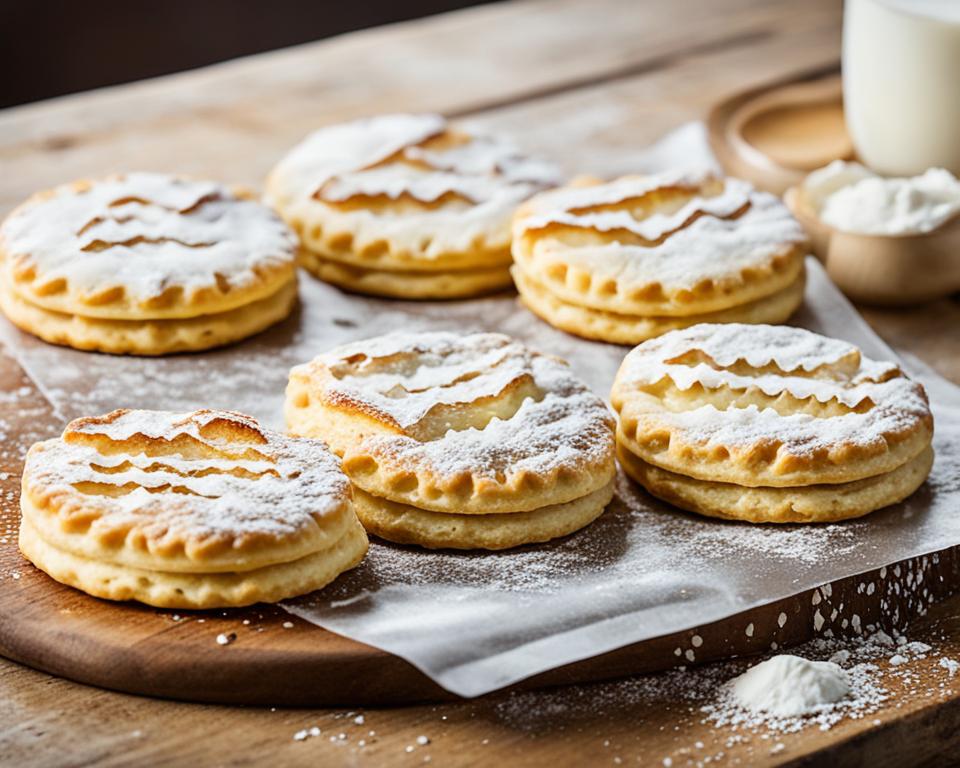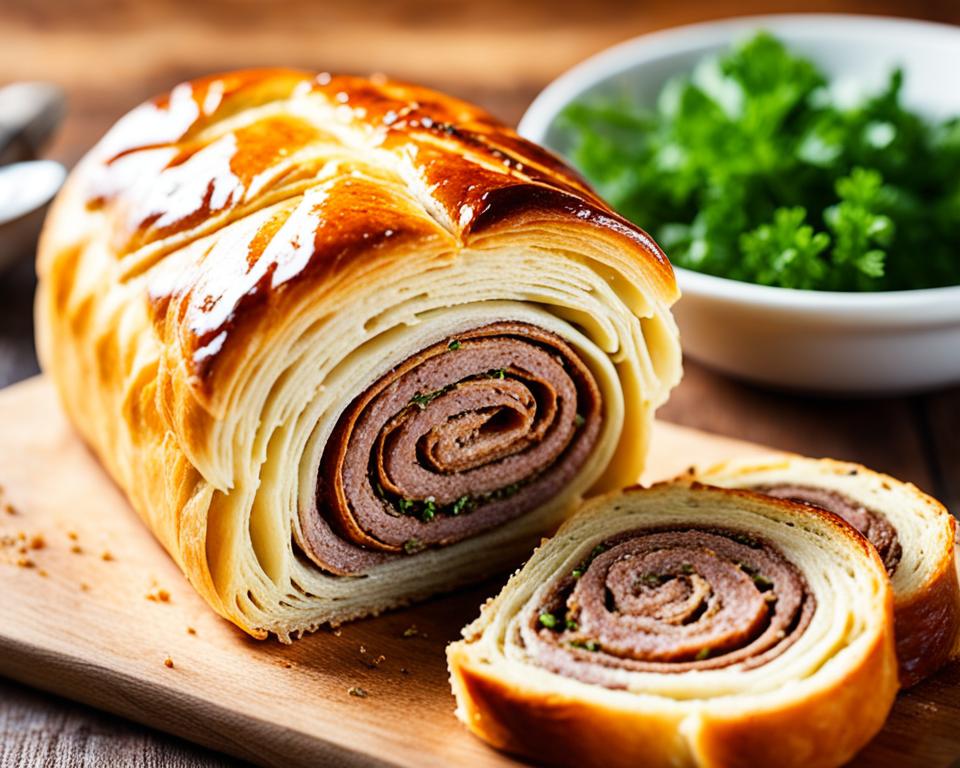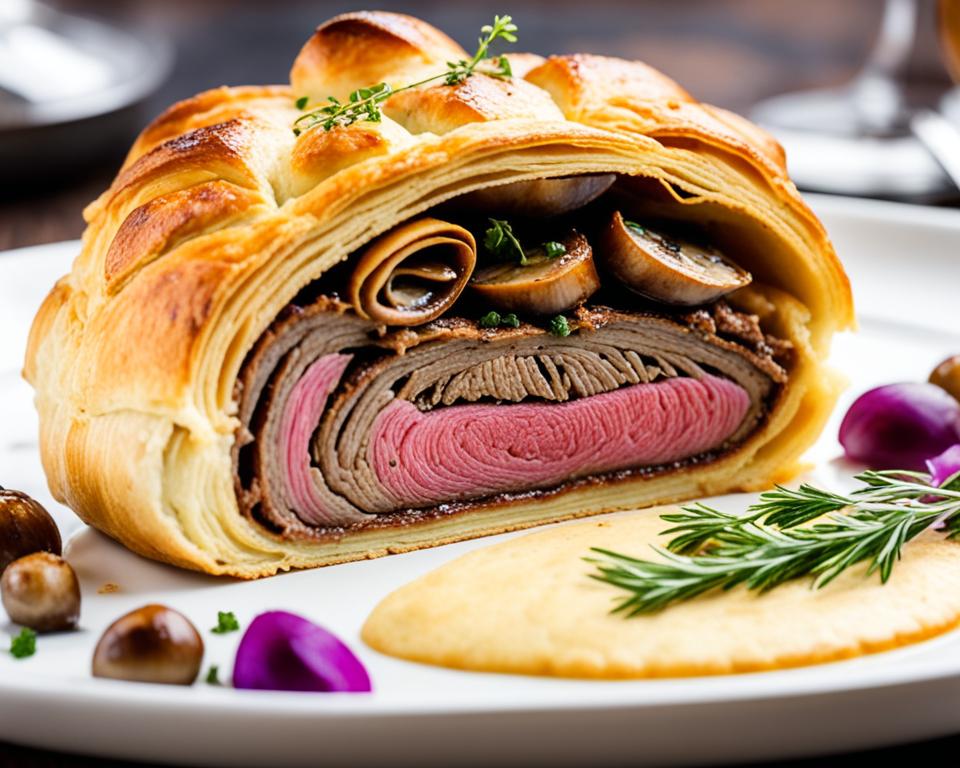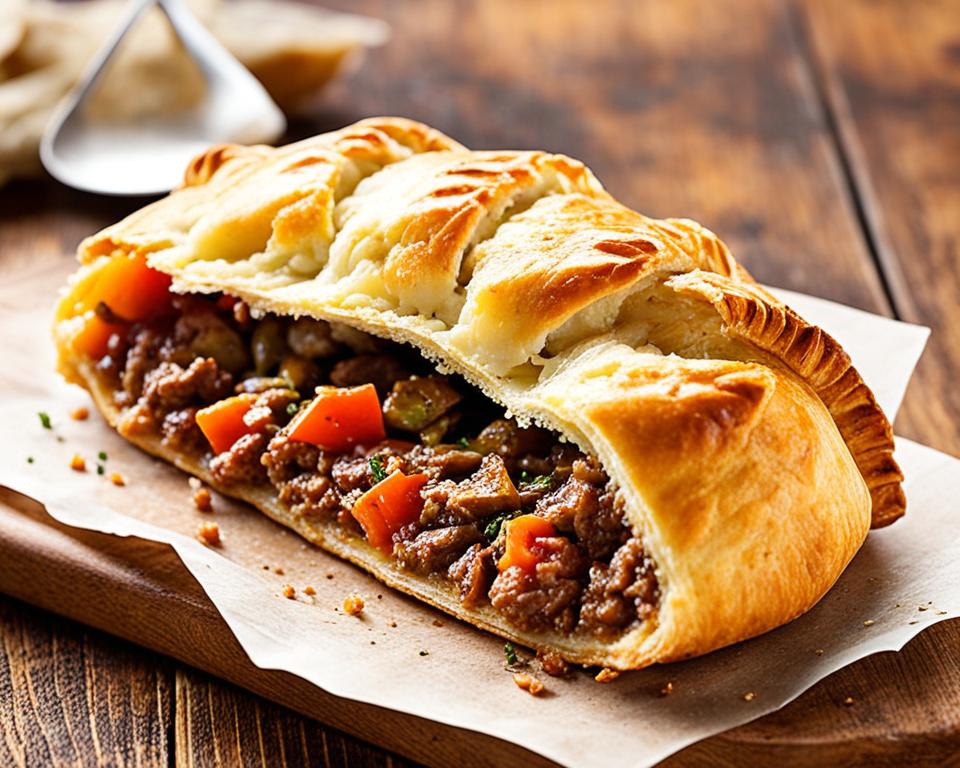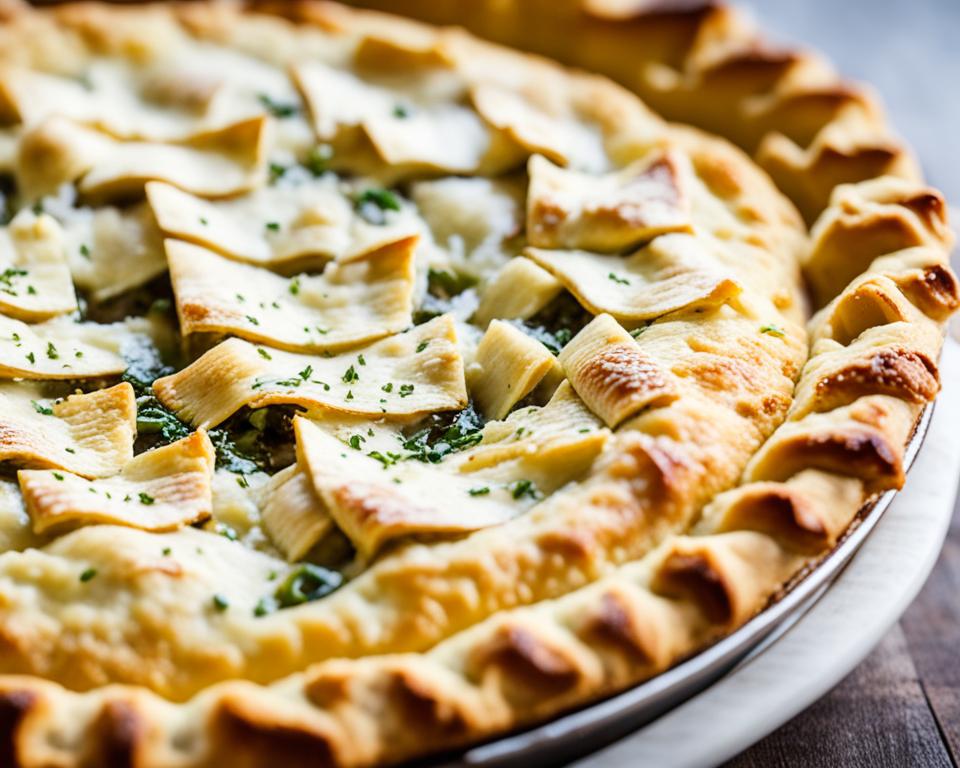Welcome to our delicious journey of discovering the secrets to making perfect flaky layer biscuits. In this homemade biscuit recipe, we will teach you how to achieve buttery, fluffy biscuits that will elevate your breakfast game. Get ready to impress your family and friends with biscuits that are light, airy, and irresistibly delicious.
There’s something truly special about a homemade biscuit. The smell of biscuits baking in the oven, the anticipation of biting into those flaky layers, and the satisfaction of knowing you created something from scratch. With our biscuit recipe, you’ll learn the techniques and tips to create those coveted flaky layers in every biscuit you make.
So, roll up your sleeves, gather your ingredients, and let’s get started on this biscuit-making adventure. Whether you’re a seasoned baker or a novice in the kitchen, we’re here to guide you every step of the way. Get ready to enjoy the pleasure of homemade biscuits that will leave everyone asking for more.
Key Takeaways:
- Learn the secrets to making perfect flaky layer biscuits.
- Master the techniques and tips to achieve buttery, fluffy biscuits.
- Discover the importance of using cold butter for flaky layers.
- Understand the technique of layering the biscuit dough for optimal results.
- Explore delicious toppings to enhance the flavor of your homemade biscuits.
The Secret to Foolproof Flaky Biscuits
Unlock the secret to foolproof flaky biscuits that will leave your taste buds craving for more. While a good recipe is essential, the technique is what sets apart ordinary biscuits from extraordinary ones. By mastering the art of using cold butter and layering the dough, you can achieve the perfect balance of buttery layers, a crisp exterior, and a tender center. Let’s dive into the details and discover how you can make foolproof flaky biscuits every time.
The Technique Behind Flaky Layers
Creating flaky layers in biscuits requires the right technique. The key is to ensure that the butter remains cold throughout the process. Cold butter forms small pockets of air when it melts during baking, resulting in those desirable flaky layers. This technique involves layering the dough multiple times to create a laminated effect, much like the layers in puff pastry.
The secret to foolproof flaky biscuits lies not only in the recipe but also in the technique. By using cold butter and layering the dough, you can achieve those crisp exteriors, peel-apart layers, and tender centers that make biscuits irresistible.
Proper Butter Handling
Properly handling the butter is crucial for achieving foolproof flaky biscuits. Start with cold butter straight from the refrigerator and cut it into small cubes or grate it using a box grater. By keeping the butter cold, you ensure that it doesn’t melt into the dough prematurely. These small pieces of butter will create pockets of steam during baking, resulting in those coveted buttery layers.
The Layering Technique
The layering technique involves rolling out the biscuit dough into a rectangle and then folding it like a letter. This process is repeated several times to create multiple layers. The stacking and rolling action creates distinct layers of dough and butter, resulting in biscuits that rise high and have a tender crumb.
The Perfect Biscuit Texture
The combination of a crisp exterior and a tender center is what makes flaky biscuits truly delightful. The layering technique, coupled with the use of cold butter, ensures that you achieve this texture. The result is a biscuit with a golden brown, flaky exterior and a soft, buttery interior that practically melts in your mouth.
Now that you know the secret to foolproof flaky biscuits, it’s time to put your newfound knowledge to the test. Armed with the right technique and a well-crafted recipe, you can create perfect buttery layers and achieve that ultimate biscuit perfection. Get ready to impress your family and friends with your mastery of the art of making flaky biscuits.
| Benefits of the Technique | How It Works |
|---|---|
| Buttery Layers | The use of cold butter and layering technique creates distinct layers of dough and butter, resulting in biscuits with buttery layers that are absolutely irresistible. |
| Crisp Exterior | The layers and the cold butter ensure that the biscuits develop a crispy exterior when baked to perfection. |
| Tender Center | The combination of the layering technique and cold butter results in a tender center for the biscuits, giving them a delightful texture. |
| Flaky Layers | The layering technique creates multiple layers of dough and butter, resulting in biscuits with beautiful, flaky layers. |
The Importance of Cold Butter
When it comes to creating flaky biscuits, the temperature of your butter makes all the difference. Cold butter is the key ingredient that helps achieve those buttery, melt-in-your-mouth layers that we all crave. But why is cold butter so important?
Well, when cold butter is incorporated into the biscuit dough, it creates tiny, pea-sized pockets of butter. As the biscuits bake, these pockets of butter melt, creating air pockets within the dough. And it’s these air pockets that give rise to those light and flaky layers we love.
To better understand the role of cold butter, imagine a biscuit without it. The butter would melt too quickly, resulting in a denser texture with fewer layers. By using cold butter, you ensure that it remains solid until it goes into the oven, allowing it to slowly release steam as it melts and creating those magical pockets of air.
“Cold butter creates tiny, pea-sized pockets of butter that melt during baking, creating airy and flaky layers in your biscuits.”
Pea-Size Butter Pieces for Perfect Layers
When incorporating the cold butter into the biscuit dough, it’s crucial to cut it into pea-sized pieces. These small butter pieces ensure that the butter is evenly distributed throughout the dough, resulting in consistent layers.
To achieve the perfect pea-sized pieces, start by cutting the cold butter into small cubes. Then, using a pastry cutter or your fingers, work the butter into the dry ingredients until you have a coarse, crumb-like texture. The key here is to leave small, visible pieces of butter in the dough.
When the biscuits bake, these visible pieces of butter will melt and create those beautiful flaky layers we all love. So don’t be afraid to leave those pea-sized butter pieces in your dough.
Proper Incorporation is Key
Properly incorporating the cold butter into the dough is essential for achieving the desired flaky layers in your biscuits. Be sure to work quickly and avoid over-mixing the dough, as this can result in melted butter and loss of the desired texture.
One technique to ensure the butter is evenly distributed is to use your fingertips or a pastry cutter to gently rub the butter into the dry ingredients. This process should be done with a light hand, being careful not to overwork the dough.
By using cold butter and incorporating it properly, you’ll create a biscuit dough that’s filled with butter pockets, ready to melt and produce those delectably flaky layers. So next time you’re making biscuits, remember the importance of cold butter and enjoy the results!
The Technique of Layering the Dough
When it comes to baking tall and flaky biscuits, mastering the technique of layering the dough is key. This technique involves a method called “stack and roll,” which helps create those light and airy layers that make biscuits truly irresistible.
Here’s how you can perfect the layering technique:
- Start by combining all the necessary ingredients for your biscuit dough. Whether you’re using a classic buttermilk biscuit recipe or experimenting with different flavors, ensure that the dough is well mixed and ready for rolling.
- Dust your work surface lightly with flour and transfer the dough onto it. Using a rolling pin, start rolling the dough into a rectangle shape. Make sure the thickness is even and approximately ½ inch.
- Once your dough is rolled out, cut it into thirds using a sharp knife or a dough scraper. These thirds will be stacked on top of each other to create the layers.
- Gently lift the top third of the dough and place it on the middle third, making sure they align evenly. Then, take the bottom third and stack it on top of the other two.
- Press the stacked layers lightly with your hands to make sure they adhere to each other. This is an important step for ensuring the layers won’t separate during baking.
- Now, you can roll out the stacked dough again into a rectangle shape, maintaining the previous thickness. The process of stacking and rolling the dough creates even more layers, guaranteeing a flaky end result.
- Repeat the stacking and rolling process one more time if desired, to create even more layers and height in your biscuits.
- Finally, use a biscuit cutter or a round cookie cutter to cut out your individual biscuits. Place the cut biscuits onto a baking sheet lined with parchment paper or a silicone baking mat.
- Bake the biscuits according to your recipe instructions until they turn a golden brown color on top. The layers within the biscuits should be beautifully visible and oh-so-flaky.
Pro Tip: Keep It Cold
Remember, maintaining cold dough throughout the layering process is essential for achieving those tall, flaky biscuits. The cold butter reacts with the heat in the oven, creating steam that expands the layers and gives the biscuits their airy texture.
With the layering technique mastered, you’re now on your way to creating bakery-worthy biscuits right in your own kitchen. The combination of stack and roll and the proper handling of the dough will result in biscuits that are tender, buttery, and oh-so-flaky. Your family and friends will be impressed by your biscuit prowess, and you’ll have a delicious treat to enjoy any time of day.
Cutting and Baking the Biscuits
Now that you’ve layered the dough, it’s time to cut and bake the biscuits. This crucial step will transform your dough into fluffy, golden brown delights that are ready to be enjoyed. Follow these tips to ensure biscuit-cutting success:
- Use a biscuit cutter to shape your biscuits. This handy tool will create uniform shapes and help your biscuits bake evenly.
- Place the cut biscuits on a silicone-lined baking sheet. The silicone lining will prevent the biscuits from sticking and help ensure a perfectly baked bottom.
- Handle the dough with care and avoid overworking it or warming the butter with warm hands. This will help maintain the desired flakiness in the biscuits.
Once your biscuits are cut and placed on the baking sheet, it’s time to bake them to perfection. Follow these guidelines for optimal results:
Preheat your oven to the recommended temperature provided in your biscuit recipe. Proper baking time and temperature are essential for achieving that golden brown hue and delicious flavor.
Bake the biscuits for the specified baking time until they turn a beautiful golden brown on the top and bottom. This will ensure that they are fully cooked and have a delightful crispness.
There’s nothing more satisfying than pulling a tray of golden brown biscuits out of the oven. The inviting aroma and the promise of buttery, flaky layers will make it hard to resist taking a bite right away.
“The perfect biscuits are golden brown on top and bottom, with a tender and flaky interior. Achieving that balance of crispness and softness is what makes them irresistible.” – Biscuit Enthusiast
Tips for Baking Biscuits:
- Always follow the recommended baking time and temperature for the best results.
- Rotate the baking sheet halfway through baking to ensure even browning.
- Allow the biscuits to cool slightly on a wire rack before serving. This will help set the flaky layers and prevent them from becoming too crumbly.
Now that your biscuits are baked to perfection, it’s time to enjoy them with your favorite toppings or as a side to a delicious meal. Get creative and explore different flavor combinations to truly savor the homemade goodness of these golden treasures.
Tips for Making Homemade Biscuits
Making homemade biscuits is a delightful culinary adventure that requires a few essential tips to ensure your biscuits turn out perfect every time. From choosing the right ingredients to mastering essential techniques, these tips will help you create mouthwatering biscuits that are sure to impress. Let’s dive in!
The Importance of Cold Butter and Milk
When it comes to achieving flaky and tender biscuits, using cold butter and milk is crucial. The cold butter creates pockets of steam as it melts, resulting in those sought-after flaky layers. Likewise, cold milk helps maintain the dough’s temperature, ensuring the butter remains cold throughout the baking process. Remember to chill the butter and milk before incorporating them into the dough to maximize their effectiveness.
The Technique of Lamination
Lamination is a technique commonly used in pastry-making that involves folding and rolling the dough to create layers. By incorporating this technique into your biscuit-making process, you can achieve that desirable lightness and flakiness. To laminate the dough, roll it out into a rectangle and then fold it in thirds like a letter. Repeat this process a few times, chilling the dough in between, to build up the layers that will give your biscuits their airy texture.
Gentle Dough Handling
When it comes to biscuit dough, gentle handling is key. Overworking the dough can result in tough and dense biscuits. To avoid this, handle the dough as little as possible. Use your fingertips or a pastry cutter to incorporate the butter into the dry ingredients until you achieve a crumbly texture. Then, carefully fold and shape the dough without kneading it excessively. By treating the dough with care, you’ll preserve the delicate texture that makes homemade biscuits irresistible.

“Handle the biscuit dough as if you’re handling a delicate treasure, and you’ll be rewarded with biscuits that melt in your mouth.” – Grandma’s Biscuit Secrets
By following these tips for making homemade biscuits, you’ll be well on your way to creating delectable treats that will impress your family and friends. Remember, the secrets lie in using cold butter and milk, mastering the lamination technique, and handling the dough gently. Enjoy the process and savor the heavenly aroma as your biscuits bake to golden perfection.
The Role of Butter in Homemade Biscuits
When it comes to homemade biscuits, butter is the key ingredient that adds flavor and creates those flaky layers you love. Understanding how to handle butter properly is essential to achieve the best results. Here’s what you need to know:
The Best Way to Handle Butter for Biscuits
Freezing butter before using it in biscuit dough is a game-changer. By freezing the butter, you ensure that it stays cold throughout the process, resulting in flakier biscuits. Here’s how to handle it:
- Place the unsalted butter in the freezer for about 15-30 minutes before you start making the dough.
- Once the butter is firm but not completely frozen, use a grater to grate it into small pieces.
- Make sure to work quickly to prevent the butter from melting.
By incorporating grated frozen butter into the dough, you create small pockets of butter that melt during baking, resulting in those beautiful flaky layers.
Why Unsalted Butter is Recommended
Using unsalted butter in biscuit recipes is typically recommended because it allows you to control the saltiness of the biscuits. You can add salt separately, ensuring the perfect balance of flavors. However, if you only have salted butter on hand, you can still use it, but be mindful of the additional salt in your recipe.
Remember, butter is not just a source of fat in biscuit recipes; it contributes to the overall flavor, texture, and appearance of the biscuits. Handling butter correctly is a key step in achieving the best results.
“Using frozen and grated butter in biscuit dough is a technique that guarantees flaky, tender biscuits every time. Don’t skip this step!”
Tasty Toppings for Your Biscuits
Biscuits are a versatile bread that can be enjoyed with a variety of toppings. From sweet to savory, there are endless possibilities to elevate your biscuit experience. Whether you prefer a classic combination or want to get creative, here are some delicious toppings to consider:
Sweet Toppings:
- Butter: Spread a pat of butter on a warm biscuit for a simple and indulgent treat.
- Honey: Drizzle honey over your biscuit for a natural sweetness that complements the flaky layers.
- Jams and Jellies: Try different fruit jams and jellies like strawberry, raspberry, or blueberry for a burst of flavor.
Savory Toppings:
- Gravy: Top your biscuit with creamy gravy, whether it’s sausage gravy, mushroom gravy, or classic country gravy.
- Fried Chicken: Take your biscuit to the next level by adding a crispy fried chicken breast. The combination of savory chicken and flaky biscuit is a match made in heaven.
- Sausages: Slice up some savory sausages and layer them on your biscuit for a satisfying breakfast or brunch option.
- Steak: Thinly sliced steak pairs wonderfully with biscuits, especially when topped with sautéed onions and melted cheese.
Explore these topping options and find the perfect combination that satisfies your taste buds. Don’t be afraid to mix and match, creating your own unique flavors with each bite. The versatility of biscuits allows you to get creative and enjoy them any time of the day.
How to Store and Reheat Biscuits
When it comes to enjoying freshly baked biscuits, proper storage and reheating techniques are key to preserving their deliciousness. Follow these best practices to ensure your biscuits stay fresh and flavorful, even after they’ve cooled down.
Storing Biscuits
After your biscuits have cooled to room temperature, it’s important to store them correctly to maintain their texture and taste. One of the easiest and most effective methods is using a zip-top bag. Here’s how:
- Place the cooled biscuits in a zip-top bag, ensuring they are not stacked on top of each other to prevent sticking.
- Close the bag securely, removing as much air as possible to minimize moisture.
- Label the bag with the date to keep track of their freshness.
- Store the bag of biscuits in the refrigerator for up to 3 or 4 days.
By storing your biscuits in a zip-top bag, you create a controlled environment that helps maintain their moisture and flakiness.
Reheating Biscuits
When you’re ready to enjoy your stored biscuits, reheating them is easy and quick. Follow these steps to bring back their warm and comforting goodness:
- Take out the desired number of biscuits from the zip-top bag.
- Individually place each biscuit on a microwave-safe plate.
- Cover the plate with a microwave-safe cover or a microwave-safe paper towel.
- Reheat the biscuits in the microwave on high for a few seconds until they are warmed through.
Be careful not to overheat the biscuits, as this can cause them to become dry. The short burst of heat will revive their flakiness and make them taste as good as freshly baked.
Remember, while reheating biscuits is a great way to enjoy them later, they are best enjoyed fresh out of the oven. So, if possible, bake only the number of biscuits you plan to consume immediately for the best eating experience.
Southern Biscuits – A Taste of the South
Southern biscuits are more than just bread. They are a cherished tradition and a symbol of Southern hospitality. These flaky, buttery delights have been a staple in Southern cuisine for generations, loved by people of all ages and backgrounds. Dive into the rich history and cultural significance of Southern biscuits, and discover why they continue to hold a special place in the hearts and palates of Southerners.
The Tradition of Southern Biscuits
Southern biscuits have deep roots in the culinary heritage of the South, dating back to the early settlers who brought their bread-making traditions from Europe. The humble biscuit quickly became an essential part of Southern meals, serving as a versatile accompaniment to breakfast, lunch, and dinner. Passed down through generations, the art of biscuit-making became a cherished family tradition, with each recipe carrying a unique story and a taste of love.
The Cultural Significance of Southern Biscuits
Beyond their delicious taste, Southern biscuits represent more than just a bread. They embody the warmth and generosity of Southern hospitality, symbolizing comfort, togetherness, and community. From casual family gatherings to elegant social events, biscuits bring people together and create lasting memories. Their presence on the table signifies that good food and good company are always welcome.
Furthermore, Southern biscuits have become an iconic symbol of the South itself. They are synonymous with Southern comfort food and a way to celebrate the region’s rich culinary heritage. Whether enjoyed alongside classic Southern dishes like fried chicken or smothered in gravy for a hearty breakfast, Southern biscuits are a proud testament to the flavors and traditions that make the South unique.
| Key Features of Southern Biscuits | Description |
|---|---|
| Flaky Layers | Southern biscuits are renowned for their flaky layers, achieved through careful dough handling and layering techniques. Each bite offers a satisfying combination of crispy exterior and tender interior. |
| Buttery Goodness | Butter is a crucial ingredient in Southern biscuits, imparting a rich, savory flavor and contributing to the tender texture. The generous use of butter ensures an indulgent experience with every bite. |
| Versatility | Southern biscuits can be enjoyed in various ways – from a simple buttered biscuit to a vehicle for hearty fillings or sweet toppings. They adapt effortlessly to different flavors and culinary styles, making them a versatile addition to any meal. |
No matter how you enjoy them, Southern biscuits are a testament to the culinary traditions and southern hospitality that make the South so special. So the next time you savor a flaky, buttery biscuit, remember that you are indulging in a taste of the South’s rich history and culture.
Conclusion
In conclusion, mastering the art of making flaky layer biscuits is achievable with the right techniques and tips. By using cold butter, layering the dough, and handling it gently, you can create biscuits that are buttery, fluffy, and irresistible.
Remember to start with cold butter and incorporate it into the dough to create those coveted flaky layers. The layering technique is crucial for achieving tall and light biscuits, so be sure to stack and roll the dough properly. And always handle the dough gently to preserve its texture.
Once you’ve mastered the basics, feel free to experiment with different toppings and flavors. Whether you prefer classic butter and honey, indulgent jams and jellies, savory gravy, or pairing your biscuits with fried chicken or sausages, the options are endless.
Now that you have the knowledge and techniques to make perfect flaky layer biscuits, it’s time to enjoy the taste of the South with these traditional delights. So, roll up your sleeves, preheat your oven, and get ready to bake your way to biscuit perfection!
FAQ
What is the secret to making perfect flaky layer biscuits?
The secret lies in using cold butter and layering the dough to achieve crisp exteriors, peel-apart layers, and tender centers that make biscuits irresistible.
Why is using cold butter important in creating flaky biscuits?
Cold butter creates small pockets of air when it melts, resulting in those coveted flaky layers in biscuits.
How do I properly handle cold butter in biscuit dough?
It’s important to have pea-size butter pieces in your dough and incorporate it properly to achieve flaky layers.
What is the layering technique in biscuit making?
The layering technique involves rolling the dough into a rectangle, cutting it into thirds, and stacking each third on top of each other to create those light and airy layers in biscuits.
How do I cut and bake the biscuits?
Use a biscuit cutter to cut out the biscuits and place them on a silicone-lined baking sheet. Bake them at the proper temperature until they turn golden brown on top and bottom.
What are some tips for making homemade biscuits?
Some tips include using cold butter and milk, utilizing the lamination technique, and handling the dough gently to achieve the best homemade biscuits.
What is the best way to handle butter for biscuits?
It’s recommended to freeze the butter before using it and grate it into small pieces. Using unsalted butter and working with it carefully will yield the best results.
What are some tasty toppings for biscuits?
Butter, honey, jams and jellies, gravy, fried chicken, sausages, steak, eggs, and more are all delicious options for enjoying your flaky layer biscuits.
How should I store and reheat biscuits?
Store leftover biscuits in a zip-top bag for up to 3 or 4 days. To reheat, simply microwave them individually for a few seconds to preserve their freshness and flavor.
What is the history and tradition of southern biscuits?
Southern biscuits have a special place in southern cuisine and are considered a staple bread. They have a rich cultural significance and have been enjoyed for generations.

